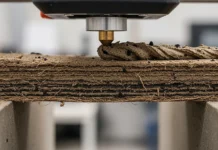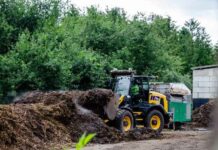Excavation is a critical step in many infrastructure, utility and construction projects, but not all excavation methods are the same. As safety regulations tighten and subsurface infrastructure becomes increasingly complex, non-destructive digging methods like hydro-excavation and air-excavation have become industry standards.
Both methods have unique advantages depending on project conditions like soil type, location, climate and scope. Explore the most important considerations to help construction professionals determine which method aligns best with their next projects.
1. Understanding the Basics
Both hydro- and air-excavation fall under the umbrella of vacuum excavation, which is an increasingly preferred method for exposing underground utilities and performing non-destructive digging. While they serve a similar function, the two methods rely on different mechanisms to break up soil and extract it from the excavation site.
Hydro-excavation uses a high-pressure stream of water to loosen the soil. The resulting slurry is then vacuumed into a debris tank. This method is especially effective in compacted or frozen ground where mechanical excavation on air methods may struggle.
Air-excavation blasts soil away with compressed air, which crews then vacuum into a tank. Because the excavated material remains dry, it can often be reused on-site, reducing material handling needs and environmental impact.
Both systems are mounted on specialized vacuum trucks and are considered safer alternatives to traditional mechanical excavation, especially in congested underground utility corridors. As utility infrastructure grows more complex, vacuum excavation continues to gain traction across sectors ranging from construction to telecommunications and energy. Hydro-excavation is generally faster than air-excavation in hard soil conditions like clay, making it a top choice for projects requiring efficient deep digging.
2. Soil Conditions and Project Location
Soil composition is one of the most influential factors in selecting between hydro- and air-excavation. The effectiveness of each method varies dramatically based on the type and consistency of the ground.
Hydro-excavation performs particularly well in dense, compacted soils such as clay or loam and is also more effective in frozen ground. The pressurized water cuts through stubborn layers quickly and efficiently. This makes it ideal for deep utility digs, foundation work, and infrastructure installation in urban environments where earth is often compacted or paved over.
On the other hand, air-excavation is most effective in dry, loose or sandy soils where compressed air can easily fracture and displace material without the need for moisture. It is often preferred in desert or arid areas where preserving the excavated material for backfill is a priority.
Site accessibility also plays a role. For example, hydro-excavation trucks may require a nearby water source or on-site refilling, while air-excavation systems can operate continuously without interruption for water replenishment. Project managers should evaluate the ground composition and the logistical feasibility of supporting equipment in the project environment.
3. Environmental and Weather Factors
The environmental impact of excavation methods has become an increasingly important consideration, especially in areas with strict regulations on waste disposal and groundwater protection. Weather conditions also heavily influence performance and feasibility.
Hydro-excavation requires large volumes of water, which must be sourced, transported and ultimately disposed of. In some cases, this can lead to added costs and regulatory complexity, particularly if slurry waste must be hauled off-site. There is also the risk of water runoff or contamination in sensitive ecosystems or urban drainage systems.
Conversely, air-excavation produces dry spoils that can often be reused as backfill, reducing environmental impact and transportation costs. Because no water is used, there are fewer disposal requirements and it is often easier to comply with environmental mandates.
Cold weather is another factor. In freezing conditions, hydro-excavation can become inefficient or even inoperable due to frozen water lines and tanks. While insulated trucks and onboard heaters mitigate some issues, air-excavation offers a clear advantage in these environments. When planning a project, environmental sensitivity and local climate conditions should be part of the early decision process to ensure operational continuity and regulatory compliance.
4. Cost Implications
When evaluating excavation methods, cost is rarely a simple matter of equipment rental fees. The total price of ownership includes labor, fuel, support services, environmental compliance and even site restoration, which are all factors that vary between hydro- and air-excavation.
Hydro-excavation tends to involve higher operational spending due to water sourcing, transport and slurry disposal. The use of pressurized water also demands more energy and specialized maintenance. In regions with limited water access or strict wastewater regulations, disposal fees can escalate quickly.
Air-excavation may offer lower disposal expenses and fewer environmental fees, since the dry material can often be redeposited on-site. Equipment tends to be simpler to maintain and requires fewer consumables, contributing to more predictable ongoing costs. However, slower digging speeds can lead to extended labor spending, particularly for larger excavation scopes.
It is also important to consider equipment availability. Hydro-excavation trucks are more commonly used and may be more readily available from rental fleets, while specialized air-excavation systems may incur delivery delays or higher rates due to niche demand.
Ultimately, cost-effectiveness depends on aligning the method with project-specific conditions. A higher daily rate may still result in overall savings if the method reduces delays, enhances safety or simplifies post-excavation work.
5. Utility Exposure and Precision
Precision and safety are paramount when excavating near underground utilities such as gas lines, fiber optics or electrical conduits. In these contexts, the method of soil removal can mean the difference between seamless progress and expensive damage.
Air-excavation is typically the method of choice for delicate utility exposure, as it poses virtually no risk of damage from pressurized fluids. The controlled stream of compressed air dislodges dirt gently, allowing workers to reveal lines or pipes with high visibility and minimal disturbance. This makes it ideal for daylighting, potholing and other utility location tasks.
Hydro-excavation, while precise, uses high-pressure water that can potentially damage fragile conduits if not properly regulated. It does, however, offer better performance in tougher soil, making it more effective for exposing utilities in difficult terrain.
The choice often comes down to the proximity and sensitivity of the utilities involved. For projects with dense underground infrastructure or aging pipelines, air-excavation may offer a safer, more targeted solution. For general excavation with limited utility interference, hydro-excavation may balance speed with acceptable precision.
6. Equipment Availability and Operator Expertise
The availability of excavation equipment and the skill level of the operators are critical factors that can influence both project timelines and outcomes. Hydro-excavation equipment is more widely adopted, while operators trained in hydro systems are generally more common, which can simplify workforce planning and reduce onboarding time.
On the other hand, air-excavation remains more specialized. The equipment may be harder to locate in certain regions, and operators with experience in pneumatic systems are less prevalent. This can introduce lead times for scheduling or require additional training, particularly if the excavation involves complex utility mapping or precise trenching.
In cases where a contractor already owns or regularly works with one type of system, sticking with familiar equipment may reduce inefficiencies. However, for unique soil or utility conditions, it may be worth investing in training or sourcing outside expertise to ensure the best fit for the project. Project managers should assess local availability and team proficiency early in the planning phase to avoid costly delays or operational missteps.
7. Regulatory and Safety Compliance
Adherence to local regulations and safety standards is nonnegotiable in modern construction environments. Vacuum excavation has become a preferred method precisely because it minimizes the risk of damaging buried utilities and improves site safety.
That said, each method comes with regulatory considerations. Hydro-excavation may require permits for water use and slurry disposal, especially in environmentally sensitive zones or urban areas with strict waste management codes. Transporting and disposing of liquid waste often involves coordination with municipal facilities, adding a layer of regulatory complexity.
Air-excavation usually involves fewer environmental restrictions, particularly since the dry spoil can remain on-site. However, it still requires compliance with OSHA standards for excavation, including spoil pile placement, confined space protocols and protective systems if digging exceeds specific depths.
Safety standards also extend to the equipment itself. Both methods require proper protective equipment, grounding and safety barriers, but hydro systems may pose additional risks related to water pressure and freezing lines in cold weather. Being proactive about compliance can help reduce liability, avoid fines and maintain smooth project momentum.
Dig In
Choosing between hydro- and air-excavation is not about which method is universally “better.” Instead, it is about which one digs deeper into your project’s specific needs. Hydro-excavation offers speed, power, and efficiency for larger or more compacted sites, while air-excavation excels in delicate utility work, environmentally restricted zones and dry spoil management.
Key considerations like soil conditions, utility sensitivity, cost structures, equipment availability and environmental compliance will ultimately steer the decision. For example, if your project calls for precision around legacy fiber lines, air-excavation might be your safest bet. On the other hand, if you are moving heavy material on a tight deadline, hydro may carry the day. So, before you break ground, take the time to weigh the ground realities. Whether it is water or air, the best method is the one that will not leave your project in a hole.































